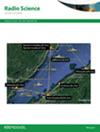用极低频测量记录的电磁闪电脉冲监测全球电离层状况
IF 1.5
4区 地球科学
Q3 ASTRONOMY & ASTROPHYSICS
引用次数: 0
摘要
雷暴闪电放电的极低频(ELF: 0.03-1,000 Hz)电磁信号可以在地球-电离层共振腔中传播到全球各地,因此可用于电离层监测。利用世界闪电定位网(WWLLN)探测到的极低频脉冲观测资料,研究了2023年9月2天内极低频脉冲的传播速度和到达方位角的日变化。太阳耀斑电离通量的暂时效应导致极低频信号的传播速度与x射线通量强度成正比地增加。我们提出了一种简单的自动大规模分析方法,利用来自两个配准系统(我们的ELF接收器和WWLLN)的数据,可以轻松评估波传播速度的变化。对非洲和美洲产生的WWLLN识别脉冲的对比分析揭示了信号折射的不同影响,随着与昼夜界限相关的电离层电离梯度的信号传播的方位角变化增加。该方法有可能成为电离层低层分析和监测的标准工具。本文章由计算机程序翻译,如有差异,请以英文原文为准。
Monitoring global ionospheric conditions with electromagnetic lightning impulses registered in extremely low frequency measurements
The Extremely Low Frequency band (ELF: 0.03-1,000 Hz) electromagnetic signals from thunderstorm lightning discharges can propagate around the globe in the Earth-ionosphere resonance cavity and thus be used for ionosphere monitoring. We use ELF observations of impulses detected by the World Wide Lightning Location Network (WWLLN) to investigate ELF propagation velocity and arrival azimuth under diurnal changes over 2 days in September 2023. Also, temporary effects of solar flares' ionizing fluxes are monitored, leading to increase of the ELF signal propagation speed in proportion to the X-ray flux intensity. We present a simple method for automatic and large-scale analysis, utilizing data from two registration systems (our ELF reciever and WWLLN) and enabling easy evaluation of changes in wave propagation speed. Comparative analysis of WWLLN identified impulses generated in Africa and America reveals varying effects of signal refraction, with increased azimuth changes for signals propagating across the ionospheric ionization gradients associated with the day/night terminator. The method has a potential to become a standard tool for the analysis and monitoring of the lower layers of the ionosphere.
求助全文
通过发布文献求助,成功后即可免费获取论文全文。
去求助
来源期刊

Radio Science
工程技术-地球化学与地球物理
CiteScore
3.30
自引率
12.50%
发文量
112
审稿时长
1 months
期刊介绍:
Radio Science (RDS) publishes original scientific contributions on radio-frequency electromagnetic-propagation and its applications. Contributions covering measurement, modelling, prediction and forecasting techniques pertinent to fields and waves - including antennas, signals and systems, the terrestrial and space environment and radio propagation problems in radio astronomy - are welcome. Contributions may address propagation through, interaction with, and remote sensing of structures, geophysical media, plasmas, and materials, as well as the application of radio frequency electromagnetic techniques to remote sensing of the Earth and other bodies in the solar system.
 求助内容:
求助内容: 应助结果提醒方式:
应助结果提醒方式:


